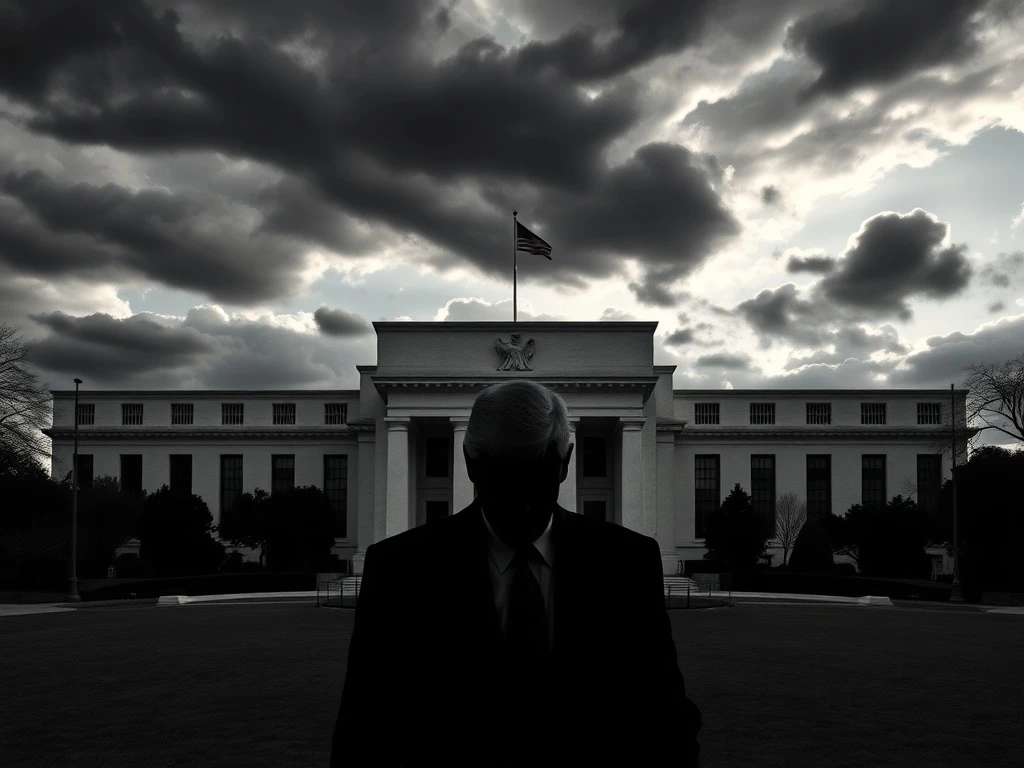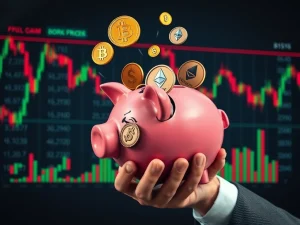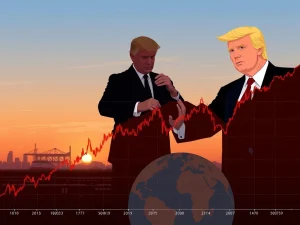Crucial Trump Fed Visit: Unpacking Escalating Tensions with Jerome Powell

Imagine a high-stakes drama unfolding right in the heart of Washington D.C., where the very foundations of economic stability are tested. That’s precisely what happened when former President Donald Trump made an unannounced Trump Fed visit to the Federal Reserve’s headquarters. This extraordinary move, a stark departure from presidential norms, sent shockwaves through financial markets and ignited intense speculation about the future of central bank autonomy. It was a moment that underscored the escalating tensions between the White House and the Fed, particularly with its chair, Jerome Powell.
The Unprecedented Trump Fed Visit: A Showdown Unfolds
On July 18, 2025, the quiet corridors of the Federal Reserve building in Washington D.C. witnessed an unusual sight: a sitting president arriving unannounced. This highly unusual Trump Fed visit was confirmed by the White House, though specific details, including whether a private meeting with Chair Jerome Powell took place, remained shrouded in secrecy. The mere presence of the President at the Fed’s doorstep, following months of scathing public criticism, spoke volumes.
- A Rare Occurrence: Presidential visits to the independent central bank are exceedingly rare, typically reserved for formal consultations rather than surprise appearances.
- Heightened Speculation: The visit immediately fueled speculation about its purpose, with many wondering if it was an attempt to directly pressure Powell or a symbolic gesture of disapproval.
- Undisclosed Details: The lack of immediate disclosure regarding the visit’s agenda or outcomes only added to the intrigue and market uncertainty.
This event wasn’t just a fleeting moment; it was the culmination of a prolonged and public feud, highlighting deep ideological differences on economic management.
Jerome Powell Under Fire: Navigating Unprecedented Attacks
The relationship between Donald Trump and Jerome Powell has been anything but conventional. For months leading up to the unannounced visit, Trump had relentlessly attacked Powell, accusing him of harming the economy with the Fed’s interest rate policies. His criticisms escalated from public admonishments to personal insults, labeling Powell as “stupid” and “terrible.”
Trump’s frustration stemmed largely from the Fed’s decision to raise interest rates during his presidency, a move he believed stifled economic growth and made the U.S. less competitive globally. He repeatedly called for Powell’s resignation, even hinting at removing him despite Powell’s term not expiring until early 2026. This aggressive stance challenged the long-standing tradition of respecting the Fed Chair’s independence and tenure.
Despite the barrage of criticism, Jerome Powell and other Fed officials consistently maintained that their decisions were guided by economic data and the central bank’s dual mandate of maximum employment and price stability, not political influence. This steadfast adherence to their mandate, even under immense pressure, became a hallmark of Powell’s leadership during this turbulent period.
Safeguarding Federal Reserve Independence: A Pillar of Stability
The core of the conflict lies in the principle of Federal Reserve independence. Established by Congress, the Fed is designed to operate free from direct political interference to ensure that monetary policy decisions are made based on economic data and long-term stability, rather than short-term political cycles. This independence is widely considered crucial for maintaining market confidence, controlling inflation, and preventing economic crises.
Historically, presidents have respected this autonomy, understanding that a politicized central bank can lead to disastrous economic outcomes. However, Trump’s presidency marked a significant departure, with his administration openly discussing ways to challenge the Fed’s autonomy, including internal discussions about investigating the central bank’s renovation project.
Why is this independence so vital?
- Long-Term Focus: An independent Fed can make unpopular but necessary decisions for the long-term health of the economy, rather than bowing to political pressure for immediate gratification.
- Credibility and Trust: Its independence builds trust among investors and the public, assuring them that decisions are impartial and based on sound economic principles.
- Insulation from Political Cycles: It prevents monetary policy from becoming a tool for electoral advantage, which could lead to boom-bust cycles.
The ongoing pressure placed on the Fed highlights a critical debate about the boundaries of presidential power and the necessity of checks and balances within the U.S. economic system.
Monetary Policy Under Scrutiny: What’s at Stake?
At the heart of the dispute is monetary policy – the actions undertaken by a central bank to influence the availability and cost of money and credit to help promote national economic goals. The Federal Reserve primarily uses interest rates, open market operations, and quantitative easing/tightening to manage inflation, employment, and economic growth.
Trump’s consistent demand for lower interest rates was a clear attempt to influence monetary policy. He believed that lower rates would stimulate the economy further and boost his administration’s economic record. While central banks do consider economic growth, their mandate also includes price stability, which sometimes necessitates higher rates to curb inflation.
The tension raised questions about whether the Fed, despite its stated independence, might subtly adjust its communication strategies to preempt further political criticism. While June meeting minutes reportedly showed no immediate plans to cut rates, the persistent public attacks undeniably create a challenging environment for the central bank to operate in. The perception of political influence, even if policy remains data-driven, can erode public and market confidence.
Aligning with the US Economic Agenda: A Broader Strategy
Trump’s actions against the Fed and Jerome Powell were not isolated incidents but part of a broader strategy to align the nation’s financial institutions with his US economic agenda. This agenda prioritized rapid economic growth, deregulation, and a strong stock market, often viewing higher interest rates as an impediment to these goals.
The administration’s efforts extended beyond public criticism. Reports indicated discussions about potential successors to Powell, with Treasury Secretary Scott Bessent signaling that candidate announcements could be expected by December 2025 or January 2026. This proactive search for a new Fed Chair, even while Powell’s term was ongoing, underscored the administration’s determination to reshape the central bank’s leadership to better suit its economic vision.
The president’s shifting stance, alternating between threats to replace Powell and claims of allowing him to serve out his term, created significant uncertainty for markets and policymakers alike. This unpredictable approach was seen by some as a tactic to keep pressure on the Fed, while others, including a faction of House Republicans, reportedly advised Trump to avoid abrupt policy changes that could destabilize the Fed’s credibility.
The Unfolding Saga: Implications for Markets and Governance
The dramatic events surrounding the Trump Fed visit and the ongoing feud with Jerome Powell have significant implications for financial markets and the future of central bank governance. For cryptocurrency markets, while not directly tied to the Fed’s interest rate decisions in the same way traditional assets are, overall market sentiment and economic stability are crucial. Uncertainty stemming from political interference in monetary policy can ripple across all asset classes, potentially increasing volatility.
The situation underscores a vital debate about the role of political pressure in monetary policy. Despite Trump’s public attacks, Fed officials have historically maintained that their decisions are guided by economic indicators, not political influence. Yet, the persistent criticism has forced the central bank to navigate a delicate balance between its independence and public perception. The saga serves as a potent reminder of the fragility of institutional norms and the importance of safeguarding the autonomy of key economic institutions.
As this unprecedented chapter in U.S. economic history continues to unfold, markets and policymakers will remain vigilant, watching for signs of collaboration or conflict. The outcome of this tension will undoubtedly shape future monetary policy and set precedents for the relationship between the executive branch and the nation’s central bank for years to come. The resilience of Federal Reserve independence will be continually tested, impacting not just the US economic agenda but global financial stability.
Frequently Asked Questions (FAQs)
1. Why was Trump’s unannounced visit to the Federal Reserve headquarters so unusual?
Presidential visits to the Federal Reserve are rare and typically highly formalized. An unannounced visit, especially amid public criticism of the Fed Chair, breaks with long-standing traditions of respecting the central bank’s independence and can be perceived as an attempt to exert undue political pressure.
2. What were Trump’s main criticisms of Jerome Powell and the Fed?
Trump primarily criticized Jerome Powell for raising interest rates, arguing that these policies were harming the U.S. economy, hindering growth, and making the country less competitive. He also expressed frustration that the Fed was not aligning its policies with his administration’s economic goals.
3. Why is Federal Reserve independence considered important?
Federal Reserve independence is crucial because it allows the central bank to make monetary policy decisions based on economic data and long-term stability, free from short-term political pressures. This helps maintain market confidence, control inflation, and prevent policies driven by electoral cycles rather than sound economic principles.
4. How does monetary policy affect the economy?
Monetary policy, managed by the Federal Reserve, influences the economy primarily through interest rates. Lower rates encourage borrowing and spending, stimulating growth, while higher rates can curb inflation by making borrowing more expensive. It also impacts employment levels and overall financial stability.
5. What are the potential implications of political pressure on the Fed?
Political pressure on the Fed can undermine its credibility, erode market confidence, and potentially lead to less effective or politically motivated monetary policy decisions. This could result in higher inflation, economic instability, and a less predictable financial environment for both traditional and crypto markets.
6. How might these tensions impact the broader US economic agenda?
The tensions between the White House and the Fed create uncertainty, which can deter investment and slow economic growth. If the Fed’s independence is perceived to be compromised, it could lead to less stable monetary policy, impacting everything from interest rates to the value of the dollar, thus directly influencing the overall US economic agenda.







